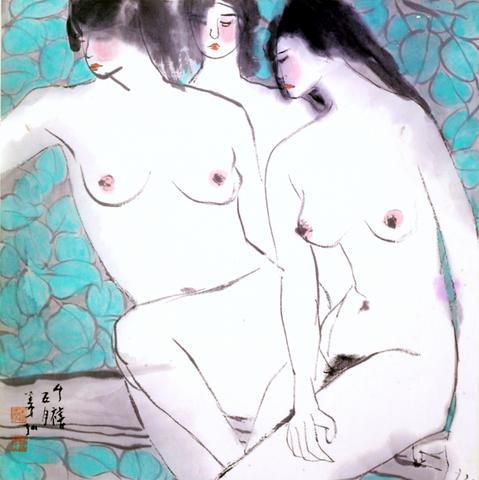Lee Yi-hong's (李義弘) journey in art has been filled with large-scale excitement. Thirty-odd years ago he began to paint under the master Chiang Chao-shen (江兆申), then serving as chief of paintings and of the calligraphy collection, and later as Deputy Director of the National Palace Museum in Taipei.
For a period of many years it was difficult to tell apart the work of Lee from that of his teacher. Chiang's very personal landscape imagery stem from the best of Chinese traditions, from his love of ancient Chinese mountains and streams running, the memories of his native land and, by dint of his work at the museum, first-hand familiarity with diverse brush-habits of great masters spanning centuries.

PHOTO COURTESY OF THE ARTIST
In Lee's works, elements of Chiang Chao-shen, shades of younger contemporaries and well-studied elements from ancient masters that have been entirely reframed in new contexts, serving new functions, truly delight with their masterful and dramatic boldness.
In Lee's oeuvre, joy radiates directly from a child's heart. The Tang dynasty scholar and demon-queller, Zhong Kuei appears in Lee's works as a memorable being with a strong personality, bursting with humor and mischief and, in an album devoted to him, is given many close-up portraits that display Lee's uncanny virtuosity and delight in lively, dramatic
expressions.
Recently, Lee has thickened his application of washes to the point of opacity, deviating from the translucency marking traditional Chinese inkwash painting. Because of Lee's experimental nature in the application of brush and ink, he has experimented with different types of paper, and with amazing results.
This may have begun with experimentations in splashed ink in the late 1980s, juxtaposing different forms of dripped tonal and formal effects yet still legible as landscapes. For a while, tree trunks were merrily swollen out of pooled ink. This has subsided in his current show where the pooling takes place on the back-side of paper as distant mountains, and the paper is again painted over on the front face creating a fresh new effect.
Lee's world is charged with life and gaiety. A most delightful discovery this visit was Lee's astonishing paintings of nudes. Lovingly limned in strong, robust strokes, one lies invitingly and relaxed, seen from the head, mirthfully covered with the Heart Sutra declaring color (the senses) to be as void and void as color. I have not seen ink-wash nudes of such beauty and accomplished brushwork as here where gentle eroticism is fired with Lee's virile brushwork and masterful calligraphy in the xiaokai small formal script. This is a new genre that Lee Yi-hong should develop into a series, to provide Chinese painting with truly outstanding examples of the nude that are easily on a par with the best of Matisse.
Exhibition notes:
What: Li I-hung (
Where: Tainan County Cultural Center, 5F, 23 Zhongcheng Rd, Xinying City, Tainan County (
When: Final day today.

On April 26, The Lancet published a letter from two doctors at Taichung-based China Medical University Hospital (CMUH) warning that “Taiwan’s Health Care System is on the Brink of Collapse.” The authors said that “Years of policy inaction and mismanagement of resources have led to the National Health Insurance system operating under unsustainable conditions.” The pushback was immediate. Errors in the paper were quickly identified and publicized, to discredit the authors (the hospital apologized). CNA reported that CMUH said the letter described Taiwan in 2021 as having 62 nurses per 10,000 people, when the correct number was 78 nurses per 10,000

As we live longer, our risk of cognitive impairment is increasing. How can we delay the onset of symptoms? Do we have to give up every indulgence or can small changes make a difference? We asked neurologists for tips on how to keep our brains healthy for life. TAKE CARE OF YOUR HEALTH “All of the sensible things that apply to bodily health apply to brain health,” says Suzanne O’Sullivan, a consultant in neurology at the National Hospital for Neurology and Neurosurgery in London, and the author of The Age of Diagnosis. “When you’re 20, you can get away with absolute

When the South Vietnamese capital of Saigon fell to the North Vietnamese forces 50 years ago this week, it prompted a mass exodus of some 2 million people — hundreds of thousands fleeing perilously on small boats across open water to escape the communist regime. Many ultimately settled in Southern California’s Orange County in an area now known as “Little Saigon,” not far from Marine Corps Base Camp Pendleton, where the first refugees were airlifted upon reaching the US. The diaspora now also has significant populations in Virginia, Texas and Washington state, as well as in countries including France and Australia.

May 5 to May 11 What started out as friction between Taiwanese students at Taichung First High School and a Japanese head cook escalated dramatically over the first two weeks of May 1927. It began on April 30 when the cook’s wife knew that lotus starch used in that night’s dinner had rat feces in it, but failed to inform staff until the meal was already prepared. The students believed that her silence was intentional, and filed a complaint. The school’s Japanese administrators sided with the cook’s family, dismissing the students as troublemakers and clamping down on their freedoms — with